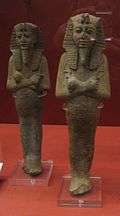Ramesses VI
| Ramesses VI[1] | |||||||||||||||||||||||||||||||||||||||||||||||||||||||||||||||||||||||||||||||||||||||||||||||||||||||||||||
|---|---|---|---|---|---|---|---|---|---|---|---|---|---|---|---|---|---|---|---|---|---|---|---|---|---|---|---|---|---|---|---|---|---|---|---|---|---|---|---|---|---|---|---|---|---|---|---|---|---|---|---|---|---|---|---|---|---|---|---|---|---|---|---|---|---|---|---|---|---|---|---|---|---|---|---|---|---|---|---|---|---|---|---|---|---|---|---|---|---|---|---|---|---|---|---|---|---|---|---|---|---|---|---|---|---|---|---|---|---|
| Ramses VI, Rameses VI | |||||||||||||||||||||||||||||||||||||||||||||||||||||||||||||||||||||||||||||||||||||||||||||||||||||||||||||
|
Fragment of a sarcophagus showing Ramesses VI, on display at the British Museum. | |||||||||||||||||||||||||||||||||||||||||||||||||||||||||||||||||||||||||||||||||||||||||||||||||||||||||||||
| Pharaoh | |||||||||||||||||||||||||||||||||||||||||||||||||||||||||||||||||||||||||||||||||||||||||||||||||||||||||||||
| Reign | 1145–1137 BC (20th Dynasty) | ||||||||||||||||||||||||||||||||||||||||||||||||||||||||||||||||||||||||||||||||||||||||||||||||||||||||||||
| Predecessor | Ramesses V | ||||||||||||||||||||||||||||||||||||||||||||||||||||||||||||||||||||||||||||||||||||||||||||||||||||||||||||
| Successor | Ramesses VII | ||||||||||||||||||||||||||||||||||||||||||||||||||||||||||||||||||||||||||||||||||||||||||||||||||||||||||||
| |||||||||||||||||||||||||||||||||||||||||||||||||||||||||||||||||||||||||||||||||||||||||||||||||||||||||||||
| Consort | Nubkhesbed[2] | ||||||||||||||||||||||||||||||||||||||||||||||||||||||||||||||||||||||||||||||||||||||||||||||||||||||||||||
| Children | Ramesses VII, Iset or Isis, Amenherkhepshef, Panebenkemyt[2] | ||||||||||||||||||||||||||||||||||||||||||||||||||||||||||||||||||||||||||||||||||||||||||||||||||||||||||||
| Father | Ramesses III | ||||||||||||||||||||||||||||||||||||||||||||||||||||||||||||||||||||||||||||||||||||||||||||||||||||||||||||
| Mother | Iset Ta-Hemdjert | ||||||||||||||||||||||||||||||||||||||||||||||||||||||||||||||||||||||||||||||||||||||||||||||||||||||||||||
| Died | 1137 BC | ||||||||||||||||||||||||||||||||||||||||||||||||||||||||||||||||||||||||||||||||||||||||||||||||||||||||||||
| Burial | KV9 | ||||||||||||||||||||||||||||||||||||||||||||||||||||||||||||||||||||||||||||||||||||||||||||||||||||||||||||
Ramesses VI Nebmaatre-Meryamun (also written Ramses and Rameses) was the fifth ruler of the Twentieth dynasty of Egypt who reigned from 1145 to 1137 BC and a son of Ramesses III by Iset Ta-Hemdjert. His royal tomb, KV9, is located near Tutankhamun's tomb in the Valley of the Kings.
Ramesses' prenomen or royal name was Nebmaatre-meryamun meaning "Lord of Justice is Re, Beloved of Amun" while his royal epithet—Amunherkhepshef Netjer-heqa-iunu—translates as "Amun is his Strength, God Ruler of Heliopolis".[3]
Reign length
The first to establish beyond doubt that Ramesses VI lived into his 8th Regnal Year was the Dutch Egyptologist Jac. J. Janssen. He based this on Ostracon IFAO 1425, which mentions the loan of an ox in year 8 of a king which can only have been Ramesses VI.[4] His 8th Regnal Year also seems to be attested in Theban graffito 1860a, which names the then serving High Priest of Amun, Ramessesnakht. In the past, this graffito has been ascribed to Ramesses X,[5] but this interpretation has been abandoned and its ascription to Ramesses VI seems by far the best solution.[6] Raphael Ventura's interesting reconstruction of a damaged sum in Turin Papyrus 1907+1908, also seems to suggest that Ramesses VI enjoyed a reign of 8 full years.[7][8] The latest scholarly publication on Egyptian chronology in 2006 also assigned Ramesses VI 8 years of rule, based on the aforementioned sources.[9] Ramesses VI probably lived for two months into his brief 9th regnal year before he died and was succeeded by his son, Ramesses VII.
Background
Ramesses VI's chief queen was Nubkhesbed who is "mentioned on a stela of Iset E (her daughter; name also spelled as Isis) from Koptos, and also in tomb KV13 in the Valley of the Kings."[10] This pharaoh would be succeeded on the throne by his son Ramesses VII.
Reign

Egypt's political and economic decline continued unabated during Ramesses VI's reign; he is the last king of Egypt's New Kingdom whose name is attested in the Sinai.[11] At Thebes, the power of the chief priests of Amun Ramessesnakht grew at the expense of Pharaoh despite the fact that Iset, Ramesses VI's daughter, was connected to the Amun priesthood "in her role as God's Wife of Amun or Divine Adoratice."[12]
Shortly after his burial, his tomb was penetrated and ransacked by grave robbers who hacked away at his hands and feet in order to gain access to his jewelry. A medical examination of his mummy which was found in KV35 in 1898 revealed severe damage to his body, with the head and torso being broken into several pieces by an axe used by the tomb robbers.[8] The creation of Ramesses VI's tomb, however, protected Tutankhamun's own intact tomb from grave robbers since debris from its formation was dumped over the tomb entrance to the boy king's tomb.
References
- ↑ Ramesses VI Nebmaatre-meryamun
- 1 2 Aidan Dodson & Dyan Hilton, The Complete Royal Families of Ancient Egypt, Thames & Hudson (2004) ISBN 0-500-05128-3
- ↑ Peter Clayton, Chronicle of the Pharaohs, Thames & Hudson Ltd, (1994), p.167
- ↑ Janssen, GM 29 (1978), 45-46
- ↑ Bierbrier, JEA 58 (1972), 195-199.
- ↑ L. Bell, Serapis 6 (1980), pp.7-16
- ↑ Raphael Ventura, More Chronological Evidence from Turin Papyrus Cat.1907+1908, JNES 42, No.4 (1983), pp.271-277
- 1 2 Clayton, p.168
- ↑ Erik Hornung, Rolf Krauss & David Warburton (editors), Handbook of Ancient Egyptian Chronology (Handbook of Oriental Studies), Brill: 2006, p.475
- ↑ Aidan Dodson & Dyan Hilton: The Complete Royal Families of Ancient Egypt. Thames & Hudson, 2004. p.193
- ↑ Nicolas Grimal, A History of Ancient Egypt, (Blackwell Books: 1992), p.288
- ↑ Grimal, p.288
Further reading
- A. M. A. Amer, Reflections on the Reign of Ramesses VI, Journal of Egyptian Archaeology 71 (1985), 66-70
- Tamás A. Bács, A Note on the Divine Adoratrix Isis, daughter of Ramesses VI, Göttinger Miszellen 148 (1995), 7-11
- Jac. J. Janssen, Year 8 of Ramesses VI Attested, Göttinger Miszellen 29 (1978), 45-46
- A.J. Peden, Where did Ramesses VI bury his nephew?, GM 181 (2001), 83-88

